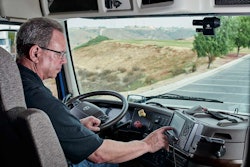
How do fleets keep their drivers engaged and loyal? Find out in this webinar.
Invest in drivers and they’ll invest in you. Join us for a live webinar on Thursday, Sept. 26 at 1 p.m. Central to cover proven ways to keep drivers engaged and loyal, including enhanced driver feedback options, improved route planning, equipment spec’ing and innovative pay models.
In this webinar, sponsored by Netradyne, you'll hear from A. Duie Pyle, Cargo Transporters and PS Logistics on how they have made their businesses successful.
One of the main selling points trucking technology companies have on their side is the claim that dash cameras, whether inward or forward facing, help improve driver safety and therefore driver retention.
Dash cameras have absolved drivers in the event of accidents, but many also offer real-time coaching in the cab when an event like hard braking, cellphone use or speeding is detected, helping to prevent those accidents to begin with.
While many trucking companies have had success with the launch of road-facing cameras, their drivers still tend to balk at the idea of driver-facing cameras. Though cameras have been hyped as a retention tool, fleets have lost drivers upon installation, as well as lost potential drivers before they ever got behind the wheel.
Pennsylvania carrier NAPA Transportation has experienced heavy pushback from its existing drivers when implementing driver-facing cameras, but it has also cost the company several potential drivers.
“Prior to even becoming employees with us, we've had individuals who, through the recruiting process, interacting with our recruiting team, when informed that we have cameras in the truck, have ceased their application attempts and have stated it’s because of the cameras,” said NAPA Safety Director Joe Salisbury. “We have new drivers that have made it into class and then quit when they realized there were cameras.”
Rookies vs. Veterans
Salisbury said age doesn’t matter.
NAPA has close to 400 drivers, aged mid to late 20s all the way up into the 70s.
Tim Chrulski, COO at Garner Trucking, said his company received opposition drivers of all ages and seniority levels as well, but he expected less resistance from younger drivers because they’re accustomed to being on camera all the time.
“They're on camera when they're using their cell phones, if they've got an iPad, if they're playing video games,” he said. “To me, (driver cameras) don't seem like a barrier to entry.”
Mike Lasko, vice president of safety at Boyle Transportation, agreed that cameras should not be a shock to a younger driver because they’ve grown up with technology. But he said it can be an abrupt change to the lifestyle of a veteran driver who started in the ‘80s when paper logs preceded ELDs.
At Boyle, veteran drivers had more concerns than rookie drivers, he said.
“There’s a lot more resistance from veteran drivers, and I don't want to say resistance in terms of like, ‘this stinks, and I don't want anything to do with it.’ More like questioning and asking how's this going to be used and what's going to happen,” Lasko said.
Mark Murrell, president of Carriers Edge, a provider of online driver training for the trucking industry, said he thinks it’s not so much about age as it is experience, just like it’s not so much about privacy as it is perception.
Newer drivers versus younger drivers isn’t necessarily the same thing, he said.
“People that are newer to the industry are a little bit more accepting, and people that are younger are definitely a lot more accepting because younger people tend to be more comfortable in a world where everything they do is monitored,” Murrell said. “And if they're new to the industry, they don't have any frame of reference; this is all they know. They don't remember a world where they weren't being monitored all the time … I can see people that are newer to the industry that maybe are older who are coming in as a second or third career and may have work experience in places where they weren't monitored. They may think it's a bit odd, but again, they don't really know any different, so they just take it.”
SDAP
The trucking industry has long complained about driver age restrictions and the negative impact it has had on the recruitment of drivers who have selected trucking as a first career. The minimum age requirement for interstate trucking is 21, so young professionals tend to seek employment in other industries first before eventually finding themselves in the driver seat of a big rig.
Chrulski said that’s because there is fear around putting an 18-year-old in that seat, but it’s an arguable point that they don’t have five to 10 years of experience handling a gun before joining the military.
“I really struggle with it for our industry because I would rather have individuals that come to the industry because they want to be here versus an individual that may be on a second or third career and is just trying to find their way,” he said. “If you're coming into the industry by default … versus making the choice to come into the industry, I think that's a pretty distinct difference there.”
Congress created the Safe Driver Apprenticeship Pilot Program as part of the bipartisan infrastructure law President Joe Biden signed in 2021 to create that direct pipeline of talent in an effort to alleviate the supposed driver shortage. The program lowers the interstate driving age, allowing participating carriers to put 18- to 21-year-olds behind the wheel. Garner is one of those participating carriers.
But the program, which aims to test whether young drivers can be safe enough to drive an 18-wheeler down the road, had a hard time getting those participants.
Many carriers claimed the requirement for driver-facing cameras was a barrier to entering the program.
Barrett Young, chief marketing officer at camera provider Netradyne, asked if it was actually deterring drivers from entering the program or if it was deterring the fleets because they don’t want to deal with implementing cameras.
Chrulski suspects the same. He said he thinks inward-facing cameras are a barrier for carriers who are opposed to adopting them in the first place. Garner implemented dash cameras – forward- and inward-facing – years before opting into SDAP, and Chrulski is a big believer in driver-facing cameras.
“If you're a carrier and you're operating with cameras, and you're using an outward-facing camera and side cameras, you're only getting 70% to 75% of the story,” he said. “There's another 25% that happens in the cab, and if you need to be able to defend the driver, defend the organization, you need to have 100% of the information.”
Where younger drivers are concerned, Young said it should be obvious that they need more safety technology because studies prove that younger people are more likely to be involved in accidents. Data also shows that cameras improve safety, he said.
Young referred to a chart that shows vehicle accidents have increased with the adoption of cellphones. Netradyne’s cameras can detect when a driver is using their phone and alert them in real time to put it down. The system also connects outward- and inward-facing cameras so if a driver is on their phone and following too close at the same time, it can send a combo alert.
“One would argue that the inward-facing cameras are equally if not more important than even the outward-facing cameras because with younger drivers, especially of this current younger generation, some of the biggest issues you're going to run into are distracted driving, which is looking at your phone,” Young said. “If you're driving an 80,000-pound truck down the road, the last thing you want to do is have an 18-year-old behind the wheel checking Facebook.”
But inward-facing cameras have been mired in such controversy, hindering recruitment and retention, to the point that the Federal Motor Carrier Safety Administration pulled the plug on requiring them to participate in SDAP.
The FMCSA did this in hopes that it would improve participation rates, but its data has not been updated since the fourth quarter of 2023, prior to its retraction of the camera requirement.
Murrell said he expects as the older generation of drivers retire and the newer generation comes in, the use of cameras in the cab won’t be as controversial and limiting.
[RELATED: The new age of driver recruitment leans into the power of social media]
“We see YouTubers, TikTok people, social media creator types in trucking that have a camera on … filming themselves while they're driving,” he said. “There are people that are putting their own inward cameras in the truck and then broadcasting what they're doing or posting it later, so it isn't as strange for that generation.”














